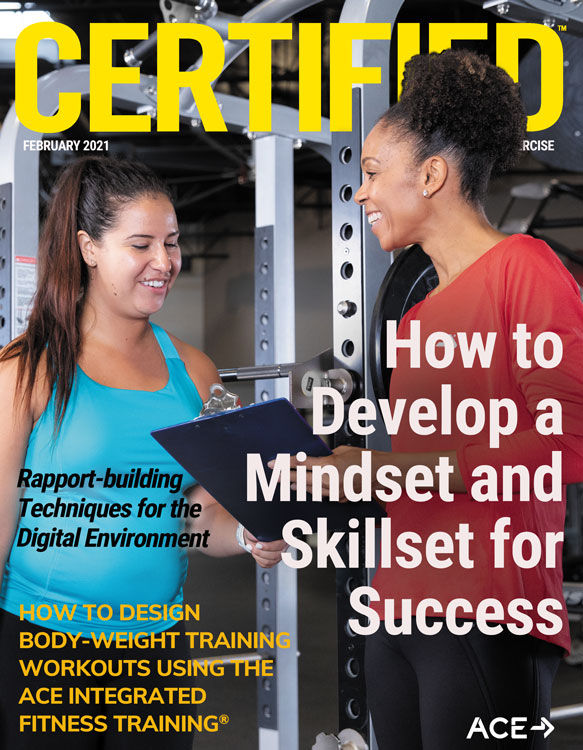
By mid-March of last year, Matt Espeut could see the sweat-splashed handwriting on the wall of his gym.
“I felt with everything going on and the way we conduct our sessions, we were in an unsafe environment,” says Espeut, 52, owner of Providence Fit Body Boot Camp. “We do high fives, we work out shoulder to shoulder.”
And so, on March 17, one week before the state of Rhode Island mandated it, he made the difficult decision to close. But he didn't go quietly. “I kept my team working,” he said. “I gave them a list every week of members to call personally.”
Espeut made sure that through calls, texts and a ramped-up social media presence, none of Providence Fit Body’s approximately 300 members felt disconnected from the gym. “A lot of gyms shut their doors and went into hiding,” he says. “We didn’t let our clients go one day without some sort of communication from us.”
In June, as the pandemic began to abate and the state appeared ready to reopen gyms, Espeut sent out a survey to his members to gauge their feelings about returning and whether they’d feel more comfortable with a combination of face-to-face and online training.
Sixty percent said they wanted to return as soon as possible.
And maybe part of that—part of the reason that, unlike so many gyms, Providence Fit Body Boot Camp came roaring back, running eight (socially distanced) classes per day—is because of the messages, the calls and the kind of concern expressed in the last question of that survey:
What can we do to better support you during this pandemic?
Of course, Espeut wasn’t volunteering his staff to do their clients’ grocery shopping (although one senses that if one of his clients had asked, he would have been in the aisles of the local food mart). No, the real lesson here, Espeut says, is an obvious one—although many gyms failed to follow it during the lockdown.
“Communication,” he says. “That’s the key to solving all problems and issues.”
What Needs to Be Said?
How can you improve your communication skills as we begin to emerge from the pandemic? What are the questions you need to ask, the messages you need to disseminate, the initiatives you might want to take—individually or in concert with your fitness facility? And how can you spark those conversations and re-open the line of communication that went dead over the past nine to 12 months?
It’s a big topic, of course, and the answers might not always be the ones a health and exercise professional wants to hear. Bob Phillips is a long-time independent trainer in Melville, N.Y., who does most of his business through in-home clients, many of whom are age 70 and older. When the lockdown started, the doors to these homes, normally open to Phillips, were shut tight. “I didn’t try to change their minds,” he said. “They were pretty firm. It wasn’t just me…no one was coming in their house.”
Moreover, some of these older clients were, in Phillip’s words, “not even Zoomable.” They didn’t want to try an online option. While one couple allowed Phillips to continue to train them on their patio, with masks—a situation that was no longer tenable once winter set in—he knows he’s facing a sobering reality. “A lot of these clients probably aren’t coming back,” he says.
The next step for Phillips? “I’ve stepped up my search for new business,” he says. That might mean advertising, in traditional venues or on social media. Although, he emphasizes, “word of mouth is the best type of advertising.”
And that’s a form of—you guessed it—communication. It’s also an area where many trainers not only fall short of the mark, they fail to realize it’s even a target!
“I think one of the biggest mistakes trainers make is not considering themselves as business communicators,” says Shannon Fable, an ACE Emeritus Board Member and veteran ACE Certified Group Fitness Instructor, Personal Trainer and Health Coach. “I’ve watched my trainers struggle even trying to put together an email to a client. It’s painful!”
Trainers need to put more thought into their communications with clients in general, Fable says. That starts with recognizing which modality the client prefers—text, email, call, social media post—and what the messaging style should be. “You have to meet them where they are, in their preferred method of communication and in the style in which they expect those communication to be written,” Fable says. “If it’s my 9 a.m. indoor cycling class with moms, where I take on the overcaffeinated cheerleader persona, a text with a smiley face is fine.” But to communicate to the 5 a.m. one-on-one executive client, who’s all business, both inside the gym and out, “an email is more appropriate.”
The content of these messages needs to be thought out, as well. A “Way to go, ladies!” text after the moms class might be an appropriate way to keep up the energy and camaraderie of the indoor cycling group. On the other hand, a “Good workout today, Ms. Jones” email to the executive should perhaps only be sent periodically—not because Ms. Jones doesn’t appreciate praise for her efforts, but because she may be so busy that a non-informational email from her trainer might end up in the junk file or be perceived as an annoyance.
Speaking of information, here’s a quick tip: There are emails that most trainers typically need to send to all clients, including an initial consultation message, a welcome and what-to-expect message for new clients, a cancellation/lateness policy message, a renewal message, etc. Fable suggests taking time to craft these emails clearly and succinctly. And then save them, so you don’t have to rewrite these boilerplate messages every time you need to send one.
What Are You Selling?
And what about your broader message? Understandably, you might be inclined to think first about your hourly rate. But attracting new clients is, in large part, a function of your ability to explain to them the value of the service you provide—not just the cost. “Instead of thinking about the price you’ll charge, let’s think about the service you’re delivering,” says Larry Indiviglia, who works with superstar trainer Todd Durkin, coaching exercise professionals at his Mastermind Institute. “Are you clear in your communications about what it is you’re selling?”
Instead of just saying you can help people reach their fitness goals, remind them why they need fitness goals in the first place—and what those goals might be. “If [a potential client] doesn’t have clarity on their ‘why,’ it’s going to be hard to get them interested in hiring or retaining you,” explains Indiviglia. But, he adds, there are many compelling reasons for someone to embark on a fitness program—which means many people may be considered potential clients. “It could be someone who wants to get in shape for a competition, feel better about themselves, or just be able to play with the grandkids.”
We all know what exercise can do, how it can make you feel. That passion and belief in the transformative power of fitness is what you need to…yes, communicate.
Which is what Matt Espeut continues to do in Providence. Even after the state shut down gyms again, this time for three weeks in December.
“When we closed for the second time, we amped up our Zoom presence, our live Facebook events and our engagement with members,” Espeut says. Providence Fit Body held some special fundraising challenges (for local charities), a selfie contest and other member promotions. The results? In another member survey, conducted near the end of the second shutdown, feedback regarding the gym’s outreach over the course of the pandemic was overwhelmingly positive. “Astonishing and humbling” is how Espeut describes the heartfelt message of appreciation he received from respondents.
Chalk it up to good communications.
Hi, there! Opening Up Your Lines of Communication
New York City−based communications consultant Raleigh Mayer is a senior fellow at the Logos Institute for Crisis Management and Executive Leadership. Mayer, whose business moniker is the “Gravitas Guru,” offers these tips for health and exercise professionals looking to step up their communications game during these challenging times:
- Act fast, and act first. Don’t wait for your clients to contact you. “You have to make the first move,” says Mayer, who also teaches leadership and communication to graduate students at Columbia University’s Fu Foundation School of Engineering and Applied Science. It’s much more impactful, she says, when the outreach comes from you. So, reach out, she says, “before they begin to wonder where you are and why you haven’t been in touch.”
- Send updates. When things change—as they have been very rapidly for the past year—make sure you let your clients know. It could be a new gym policy. It could be your availability—maybe you’re now offering online training. It could be a new lockdown or a new loosening of restrictions. Or maybe it’s just sharing an article you found that discusses the benefits of exercise during the pandemic. “Whatever it is, you don’t want them to have to come looking for you, wondering about your schedule or access or changes in policy,” Mayer says. “Anticipate their questions and provide the answers as best you can.”
- A lack of response does not necessarily mean “No.” Silence is not a rejection. “Even if you’re not getting a response, don’t assume that’s a rejection of your services,” Mayer says. It could be that the time isn’t right, or that they need more information or assurance before they resume training. It could be any number of things. “Right now, with the world in chaos, it’s hard to read moods,” says Mayer. Stay in touch, and assume this person is still your client until you’ve been told otherwise.
- Personalize when possible. Avoid mass emails or generic group texts to clients. “When possible, refer to something you know about,” Mayer suggests. “Maybe ask about children, pets, whether they’ve been able to knit more sweaters while they’ve been in quarantine, whatever,” she says. “The more you can show people that you’re paying attention to them, the stronger the relationship will be, even when the relationship is temporarily on hold.”
- Avoid the transactional in your messages. By this, Mayer says, “I mean that you should try to avoid making your messages into blatant sales pieces,” she says. “It’s not about ‘come back and we’ll give you two sessions for the price of one.’ It’s ‘we really miss you, we hope you’re doing okay, please let us know if I can help with anything.’ And then if it’s true, you can add, ‘Oh and just FYI, the gym has lowered rates during the winter.’” Remember that you’re not just marketing your services, you’re managing a relationship—and, as is the case between many health and exercise professionals—an often intimate and close relationship about something vital to your clients: their health.
- Pick up the phone—and not necessarily to send a text. These days, we tend to default to texts and emails in our personal and business communication. But, Mayer says, “A phone call is the most impactful, even if you’re just leaving a message. The human voice carries more emotion than most written messages can.” So, if you are able to, she recommends a phone call as your first choice for communications, particularly with long-time clients you haven’t seen in a while because of the pandemic.
It’s all part of that relationship-building and reminding your clients that they are important. “Everybody needs to feel special and listened to,” Mayer says. “You may have 20 or 30 clients, but they probably have only one trainer.”





 by
by 


